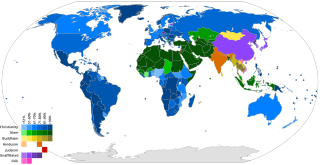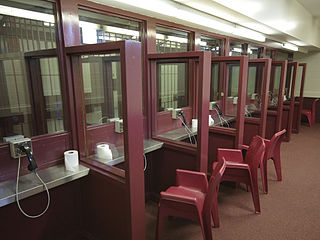Religious conversion is the adoption of a set of beliefs identified with one particular religious denomination to the exclusion of others. Thus "religious conversion" would describe the abandoning of adherence to one denomination and affiliating with another. This might be from one to another denomination within the same religion, for example, from Protestant Christianity to Roman Catholicism or from Sunnī Islam to Shīʿa Islam. In some cases, religious conversion "marks a transformation of religious identity and is symbolized by special rituals".

A religious denomination is a subgroup within a religion that operates under a common name and tradition among other activities. The term refers to the various Christian denominations. It is also used to describe the five major branches of Judaism. Within Islam, it can refer to the branches or sects, as well as their various subdivisions such as sub-sects, schools of jurisprudence, schools of theology and religious movements.

A chaplain is, traditionally, a cleric, or a lay representative of a religious tradition, attached to a secular institution, or a private chapel.
The United Kingdom has three distinct legal systems with a separate prison system in each: one for both England and Wales, one for Scotland, and one for Northern Ireland. As of January 2023, the United Kingdom has the highest per-capita incarceration rate in Western Europe, at 136 people per 100,000 in England and Wales; 134 people per 100,000 in Scotland; 88 people per 100,000 in Northern Ireland; and the largest prison population in Western Europe. The total UK prison population was 81,806, 78,699 men (96.2%) and 3,107 women (3.8%) as of the end of 2022.
Proselytism is the policy of attempting to convert people's religious or political beliefs. Carrying out attempts to instill beliefs can be called proselytization.
Prison Fellowship is the world's largest Christian nonprofit organization for prisoners, former prisoners, and their families, and a leading advocate for justice reform.

The traditional beliefs and practices of African people are highly diverse beliefs that include various ethnic religions. Generally, these traditions are oral rather than scriptural and are passed down from one generation to another through folk tales, songs, and festivals, and include beliefs in spirits and higher and lower gods, sometimes including a supreme being, as well as the veneration of the dead, and use of magic and traditional African medicine. Most religions can be described as animistic with various polytheistic and pantheistic aspects. The role of humanity is generally seen as one of harmonizing nature with the supernatural.
Hispanic and Latino American Muslims are Hispanic and Latino Americans who are of the Islamic faith. Hispanic and Latino Americans are an ethnolinguistic group of citizens of the United States with origins in Spain and Latin America. Islam is an Abrahamic, monotheistic religion teaching that there is only one God (Allah), and that Muhammad is a messenger of God. The primary scriptures of Islam are the Quran, claimed to be the verbatim word of God, and the teachings and normative examples of Muhammad. Muslims believe that Islam is the complete and universal version of a primordial faith that was revealed many times before through prophets including Adam, Abraham, Moses and Jesus, and the Quran in its Arabic to be the unaltered and final revelation of God. The Spaniards took the Roman Catholic faith to Latin America via imperialism and colonialism; Roman Catholicism continues to be the largest, but not the only, religious denomination among most Hispanics. In contrast, the Arabs took Islam to very few Latin American countries such as Mexico, El Salvador, Guatemala and Colombia via post-independence immigration.
Modern pagans are a religious minority in every country where they exist and have been subject to religious discrimination and/or religious persecution. The largest modern pagans communities are in North America and the United Kingdom, and the issue of discrimination receives most attention in those locations, but there are also reports from Australia and Greece.
Inmates incarcerated in the United States penal system practice a variety of religions. Their basic constitutional right to worship has been reinforced by decades of court decisions and more recently by the Religious Land Use and Institutionalized Persons Act. However, several of these court rulings have also set limitations on these rights when prisoner demands are seen to impede prison safety and function.
Freedom of religion in Comoros is addressed in the constitution. However, there are limitations to this right in practice. While government authorities continued to prohibit Christians from proselytizing, there were no known instances where the local authorities and population restricted the right of Christians to practice other aspects of their faith. There was societal discrimination against non-Muslims in some sectors of society; however, accounts of social pressure were anecdotal. Proselytizing for any religion except Islam is illegal, and converts from Islam may be prosecuted under the law. However, such prosecutions are rare and have not resulted in any convictions in recent years. In the past, there were reports of family and community members excluding non-Muslim converts from schools or villages for "evangelizing Muslims".
The Constitution of Bahrain states that Islam is the official religion and that Shari'a is a principal source for legislation. Article 22 of the Constitution provides for freedom of conscience, the inviolability of worship, and the freedom to perform religious rites and hold religious parades and meetings, in accordance with the customs observed in the country; however, the Government has placed some limitations on the exercise of this right.
The constitution of the Syrian Arab Republic guarantees freedom of religion. Syria has had two constitutions: one passed in 1973, and one in 2012 through the 2012 Syrian constitutional referendum. Opposition groups rejected the referendum; claiming that the vote was rigged.
Cruz v. Beto, 405 U.S. 319 (1972), was a United States Supreme Court case in which the court upheld a Free Exercise claim based on the allegations that the state of Texas had discriminated against a Buddhist prisoner by "denying him a reasonable opportunity to pursue his Buddhist faith comparable to that offered other prisoners adhering to conventional religious precepts."
Conversion to Islam in U.S. prisons refers to the contemporary high rate of conversion to Islam in American prisons, for which there are a number of factors. It is the fastest growing religion in U.S. prisons, where the population is 18 percent Muslim ; 80 percent of all prison religious conversions are to Islam.
Conversion to Islam in prisons refers to the modern phenomenon seen in the Western world of a statistically high incidence of incarcerated criminal non-Muslims converting to Islam while in the prison system. In the decade preceding 2014, the number of conversions to Islam among prisoners in Western countries outpaced all other religions, with the overall imprisoned Muslim population growing as a result.

Carol S. Vance Unit is a Texas Department of Criminal Justice (TDCJ) prison located in unincorporated central Fort Bend County, Texas. The unit, located in flatlands, is along U.S. Highway 90A, 4 miles (6.4 km) east of central Richmond. The facility is in proximity to Sugar Land, and it is about 20 miles (32 km) southwest of Downtown Houston. The unit, with about 940 acres (380 ha) of land, is co-located with Jester I Unit, Jester III Unit, and Jester IV Unit. The unit consists of four steel buildings and two brick buildings. The prison is the home of the Prison Fellowship Academy Christian prison program. It is located on the Jester State Prison Farm property.
The InnerChange Freedom Initiative (IFI) was an American Christian prison program operated by Prison Fellowship International (PFI), a 501(c)(3) nonprofit established by Chuck Colson. The program was closed in 2016.

Relationships of incarcerated individuals are the familial and romantic relations of individuals in prisons or jails. Although the population of incarcerated men and women is considered quite high in many countries, there is relatively little research on the effects of incarceration on the inmates' social worlds. However, it has been demonstrated that inmate's relationships play a seminal role in their well-being both during and after incarceration, making such research important in improving their overall health, and lowering rates of recidivism.
In the United States of America, Prisoner Law refers to litigation that determines the freedoms that a prisoner either holds or loses when they are incarcerated. This includes the end of the Hands- Off Doctrine and the ability to be protected by the First, Fourth, Eighth, and Fourteenth Amendments. Furthermore, prisoner laws regulate the ways in which individuals experience privacy in a prison setting. Important case laws have arisen through time that have either hindered or protected prisoners from certain rights. Some include the Hudson v. Palmer case which held that prisoners were not protected against searches and seizures of their prison cells and Wolff v. McDonnell that stated that prisoners shall remain entitled to some of their constitutional rights even after being incarcerated.






